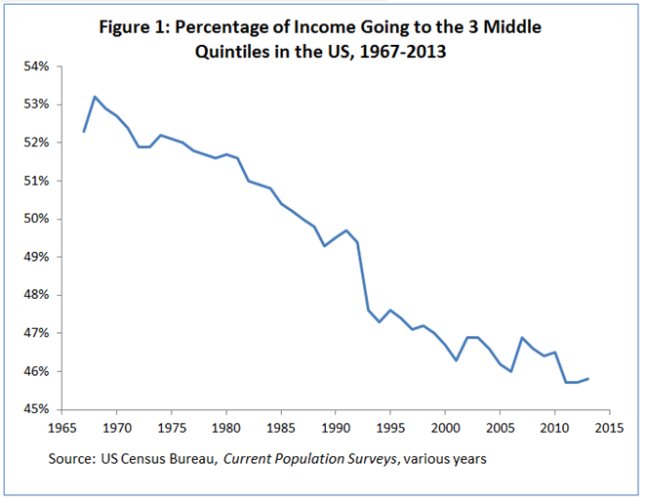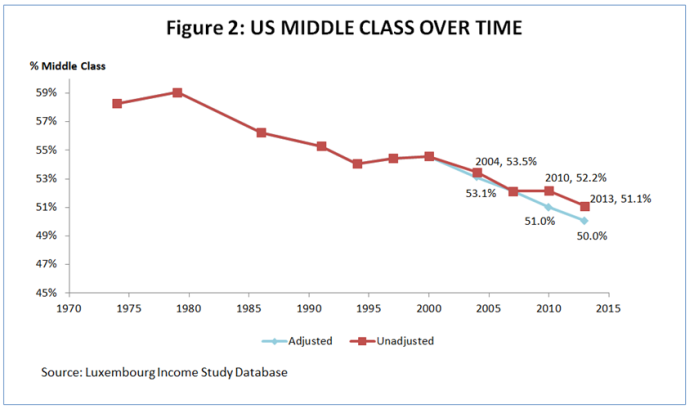From Steve Pressman As the rich received a bigger piece of the pie, everyone else got relatively less. We can see this in the falling share of income going to the middle-three income quintiles (Figure 1). One standard economic argument for great inequality is that it generates incentives to make money and contributes to economic growth, which increases average living standards. Even if this is true, not everyone benefits from growth. Saez and Piketty (2013) estimate that since the late 1970s nearly 60% of all gains from growth have gone to the top 1%, roughly those making 0,000 or more in 2016.1 Consequently, a typical US household has seen little improvement in their absolute standard of living for several decades. We can see this in figures on real median household income, which
Topics:
Editor considers the following as important: Uncategorized
This could be interesting, too:
tom writes The Ukraine war and Europe’s deepening march of folly
Stavros Mavroudeas writes CfP of Marxist Macroeconomic Modelling workgroup – 18th WAPE Forum, Istanbul August 6-8, 2025
Lars Pålsson Syll writes The pretence-of-knowledge syndrome
Dean Baker writes Crypto and Donald Trump’s strategic baseball card reserve
from Steve Pressman
As the rich received a bigger piece of the pie, everyone else got relatively less. We can see this in the falling share of income going to the middle-three income quintiles (Figure 1).
One standard economic argument for great inequality is that it generates incentives to make money and contributes to economic growth, which increases average living standards. Even if this is true, not everyone benefits from growth. Saez and Piketty (2013) estimate that since the late 1970s nearly 60% of all gains from growth have gone to the top 1%, roughly those making $500,000 or more in 2016.1 Consequently, a typical US household has seen little improvement in their absolute standard of living for several decades. We can see this in figures on real median household income, which increased only slightly over the past quarter century – growing from $54,432 in 1988 to $56,516 in 2015.
We focus here on another distributional measure – the size of the middle class. A thriving middle class is important for a number of reasons. First, there are political factors. Rothstein & Uslaner (2005, p. 52) argue that inequality reduces social capital or the trust needed to sustain democracy. Second, Robert Malthus (2008[1803], p. 594) noted: “Our best grounded expectations of an increase in the happiness of the mass of human society are founded in the prospect of an increase in the relative proportions of the middle parts.” For Malthus, the additional income that moves one from poverty into the middle class is what makes life worthwhile. Finally, a large middle class improves economic performance. Alfred Marshall (1920, pp. 529-32, 566-9) noted that higher earnings may improve the habits of working people, thereby improving productivity and everyone’s standard of living. From a Keynesian perspective, a large middle class increases consumption, effective demand and economic growth because middle-class households tend to spend larger fractions of their income than wealthy households. . . . .
Figure 2 plots the percentage of middle-class households in the US between 1974 and 2013 using our methodology and the Luxembourg Income Study (LIS),4 an international database of income and socio-demographic information. LIS data for the US came from annual Census Bureau household surveys.
Undoubtedly the US middle class has shrunk since the 1980s, when it comprised 59% of all households. The only exception was the economic boom of the late 1990s when the size of the US middle class held steady. Figure 2 also shows what happens when our computations do not allow median household income to fall. The main adjustments occur after the Great Recession. In 2010, median household income for a family of four was $4,800 below the inflation-adjusted figure for 2007. Taking this into account reduces the size of the middle class by 1.2 percentage points. In 2013 median household income for a family of four was more than $5,100 below the inflation-adjusted figure for 2007. Using the higher real median income from 2007 reduces the size of the US middle class to just 50% in 2013.



